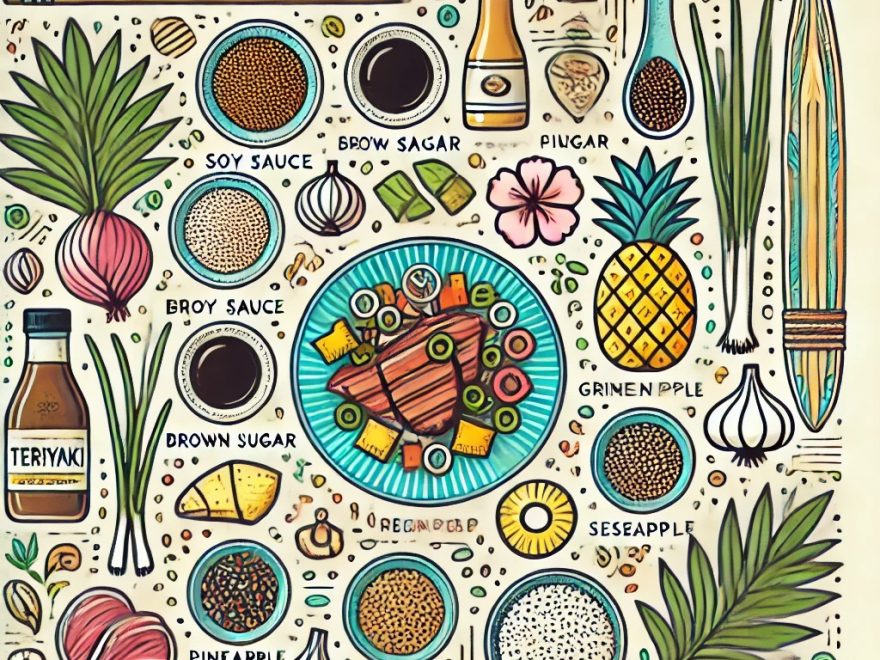Hawaiian cuisine is known for its balance of sweet, savory, and umami flavors, and few dishes capture this better than Hawaiian teriyaki. Whether it’s chicken, beef, or even seafood, Hawaiian teriyaki dishes bring a unique island twist to the traditional Japanese-style teriyaki. The key to this dish’s popularity lies in its simple yet flavorful ingredients that create a delicious glaze perfect for grilling.
If you’ve ever visited a Hawaiian grill, you’ve likely enjoyed the caramelized, smoky flavors of teriyaki chicken or beef, often served with rice and macaroni salad. But what exactly goes into making authentic Hawaiian teriyaki? Let’s break down the essential ingredients that give this dish its signature taste.
- Shoyu (soy sauce)
Shoyu, or soy sauce, is the base of any good teriyaki marinade. While Japanese teriyaki sauce typically uses light soy sauce, Hawaiian-style teriyaki often incorporates Hawaiian shoyu, a slightly sweeter and less salty version of soy sauce.
Why it’s important:
- Adds deep umami flavor
- Balances sweetness with saltiness
- Acts as the base for the marinade, absorbing into the meat for a rich taste
- Brown sugar
Traditional Japanese teriyaki relies on mirin for sweetness, but Hawaiian-style teriyaki often uses brown sugar instead. This gives the dish a deeper, slightly molasses-like sweetness that caramelizes beautifully when grilled.
How it enhances the dish:
- Creates a thick, sticky glaze when cooked
- Helps the meat develop a slightly crispy, caramelized exterior
- Balances the saltiness of the shoyu
- Some variations also use honey or pineapple juice for extra sweetness and a tropical touch.
- Garlic and ginger
Fresh garlic and ginger are essential in Hawaiian teriyaki dishes. These two ingredients add a bold, aromatic depth that complements the sweetness and umami of the marinade.
Why they’re essential:
- Garlic provides a rich, savory base flavor
- Ginger adds a slightly spicy, warming kick
- Both help tenderize the meat while adding complexity to the dish
- Most Hawaiian teriyaki marinades include minced garlic and grated ginger to ensure these flavors infuse into the meat.
- Pineapple juice
One of the biggest differences between Hawaiian and traditional Japanese teriyaki is the use of pineapple juice in the marinade. This tropical ingredient not only adds natural sweetness but also acts as a tenderizer, breaking down proteins in the meat for a melt-in-your-mouth texture.
Why it’s a must-have:
- Adds a subtle fruitiness that enhances the island flavor
- Helps tenderize chicken, beef, or pork
- Creates a slightly tangy contrast to the rich soy and sugar mixture
Some Hawaiian teriyaki recipes even include crushed pineapple for an extra burst of sweetness.
- Sesame oil
A small amount of sesame oil goes a long way in adding depth to Hawaiian teriyaki marinades. This ingredient brings a nutty, toasty flavor that enhances the overall richness of the dish.
How it helps:
- Adds a slight smokiness and nutty aroma
- Balances the sweetness with a rich, earthy note
- Helps create a well-rounded, restaurant-quality marinade
- Green onions and sesame seeds
After the meat is grilled and glazed, Hawaiian teriyaki dishes are often finished with chopped green onions and toasted sesame seeds. These garnishes add a fresh crunch and a slight bitterness that balances the sweetness of the sauce.
Why they’re great additions:
- Green onions add a mild sharpness and color contrast
- Sesame seeds provide texture and enhance the nutty flavor of the sesame oil
- Both make the dish visually appealing and restaurant-worthy
How Hawaiian teriyaki is prepared and served
Marination process
Unlike some quick-cook dishes, Hawaiian teriyaki benefits from marinating for several hours or overnight. This allows the flavors to deeply penetrate the meat, making it more flavorful and tender when cooked.
Grilling for the best flavor
The best Hawaiian teriyaki is grilled over an open flame, which gives the meat a smoky, slightly charred flavor. Some Hawaiian grill restaurants use traditional charcoal or wood-fired grills to enhance the taste. However, you can also cook teriyaki on a stovetop griddle or pan if grilling isn’t an option.
Common side dishes
Hawaiian teriyaki is usually served with:
- Steamed rice: The perfect neutral base to soak up the flavorful sauce
- Macaroni salad: A creamy, tangy contrast to the sweet and smoky teriyaki
- Grilled pineapple: A juicy, caramelized addition that complements the sauce
- Lomi lomi salmon: A fresh and salty side that balances the rich flavors
Hawaiian teriyaki in catering and events
Hawaiian teriyaki isn’t just popular at restaurants—it’s also a favorite choice for catering. Many catering services in downtown Santa Cruz offer Hawaiian-style teriyaki as part of their event menus, making it a great option for parties, weddings, and corporate gatherings.
Why teriyaki is great for catering:
- Crowd-pleaser: The sweet, smoky flavors appeal to almost everyone
- Easy to serve: Can be grilled on-site or pre-marinated for quick cooking
- Pairs well with many sides: Can be customized with rice, salads, and tropical fruits
- Can be adapted for dietary needs: Works well with chicken, beef, tofu, or seafood
Many catering companies offer Hawaiian food platters featuring teriyaki chicken, rice, mac salad, and other island favorites, making it a convenient and delicious option for events of any size.

